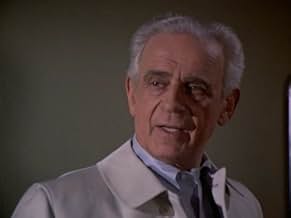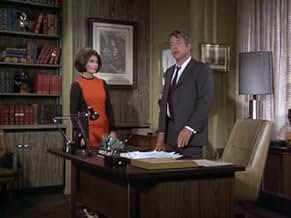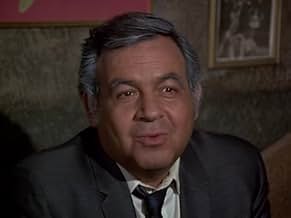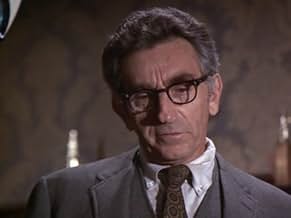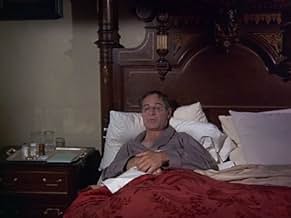Aggiungi una trama nella tua linguaRod Serling presents tales of horror illustrated in various paintings.Rod Serling presents tales of horror illustrated in various paintings.Rod Serling presents tales of horror illustrated in various paintings.
- Candidato a 2 Primetime Emmy
- 2 vittorie e 4 candidature totali
Sfoglia gli episodi
Recensioni in evidenza
10sskelton
Often lost in the shadow of Rod Serling's first series, "The Twilight Zone," "Night Gallery" was a fascinating experiment in the anthology format. Instead of one story per episode, the hour was splintered into two, three, or four different stories of varying length. Some were quite brief, lasting no more than a minute; others lasted over 40 minutes. The quality often varied, too. A few of the little vignettes were quite bad. Some stories were quite good. And on more than a few occasions, this little mini-film festival on Wednesday nights produced segments that were as good as anything else on TV at the time. Classic episodes included "They're Tearing Down Tim Riley's Bar," "Pickman's Model" (both nominated for Emmys), "The Caterpillar," "Class of '99," "Green Fingers," "The Messiah on Mott Street," "The Sins of the Fathers," "The Doll," "Cool Air," "Silent Snow, Secret Snow," "A Question of Fear," "The Little Black Bag," and "The Dead Man." Because one of these classics could often be followed or preceded by a story of lesser quality, the series got a reputation for being wildly uneven. It was universally lambasted during its network run by near-sighted critics who were thrown off by its inconsistency, and missed the quality elements: intelligent, stylish writing by Serling and others, top-notch production values (particularly in cinematography and music), and innovative directorial touches. For its syndication run, the series segments were butchered to fit into a half-hour time slot, some losing half their length in the editing, and is a travesty, a mere shadow of its former self. Episodes of a boring ESP potboiler, "The Sixth Sense," were annexed into the syndie package with terrible results. Stick to the uncut version.
One of the most underrated TV series of the 1970s, and of all time, is this terrific collection of sci-fi and horror stories, hosted by Rod Serling. Often (wrongly) compared to Serling's other series, "The Twilight Zone"...the overall mood, and purpose of this series is different. The "Zone" was a collection of morality tales, disguised as sci-fi stories. A fantastic show, without a doubt, but the "Gallery" was designed purely to shock and entertain...and it certainly succeeded in that area.
So much great talent was on display in this series. The actors, writers, directors, and musicians were almost always top-notch. Though the decision to have multiple stories within each episode, did result in some mediocre results sometimes (especially with the campy vignettes), the quality of the better segments is what most remember best.
Among some of the better segments:
"They're Tearing Down Tim Riley's Bar", with William Windom (in an awesome performance) as a has-been salesman who's beckoned by the ghosts of his past.
"The Doll", about a gruesome doll, sent to a British officer as revenge.
"The Tune in Dan's Cafe", about a haunted jukebox that plays the same song always.
"Green Fingers", with Elsa Lanchester as an elderly woman, harassed by a tycoon who wants her land, where she has an unusual knack for gardening.
So many more great ones. Some folks get turned off by the dated 1970s look to this show (the costumes, sets, bright color, excessive use of zooms/close-ups). If you can get past that aspect, and rather appreciate the show's camp value, you're sure to enjoy this unique and highly original horror series. It's a classic in my book.
So much great talent was on display in this series. The actors, writers, directors, and musicians were almost always top-notch. Though the decision to have multiple stories within each episode, did result in some mediocre results sometimes (especially with the campy vignettes), the quality of the better segments is what most remember best.
Among some of the better segments:
"They're Tearing Down Tim Riley's Bar", with William Windom (in an awesome performance) as a has-been salesman who's beckoned by the ghosts of his past.
"The Doll", about a gruesome doll, sent to a British officer as revenge.
"The Tune in Dan's Cafe", about a haunted jukebox that plays the same song always.
"Green Fingers", with Elsa Lanchester as an elderly woman, harassed by a tycoon who wants her land, where she has an unusual knack for gardening.
So many more great ones. Some folks get turned off by the dated 1970s look to this show (the costumes, sets, bright color, excessive use of zooms/close-ups). If you can get past that aspect, and rather appreciate the show's camp value, you're sure to enjoy this unique and highly original horror series. It's a classic in my book.
Everyone knows the genius of Rod Serling's science fiction, suspense series, THE TWILIGHT ZONE. NIGHT GALLERY was a different sort of series, bringing horror to the small screen. Stories by the likes of H.P. Lovecraft, Richard Matheson, and Robert Bloch were presented weekly, in a macabre art museum setting. Serling himself was the "curator" / host. Each episode was like a mini-feature film. There was great care and quality involved.
The reason this show never reached the same stellar status that TTZ did is easy to discern. While the first season is filled with many classic episodes featuring supernatural, sometimes surreal tales, studio meddling and economic pressures doomed the later seasons to a more conventional TV hell.
The network -obviously- was only concerned with better ratings / profit, so, it demanded shorter segments, more "accessible" stories, and, of course, comedy. Serling, being the eternal iconoclast, hated this nonsense, but had no real choice. If it had all been done his way, without the tampering, NIGHT GALLERY would have been a horror masterpiece. As it stands, it has the first season of brilliance, followed by a second decent season, and a third that is hit and miss. Still, this show was unique, and even its worst episodes were better than most of the rubbish on TV...
The reason this show never reached the same stellar status that TTZ did is easy to discern. While the first season is filled with many classic episodes featuring supernatural, sometimes surreal tales, studio meddling and economic pressures doomed the later seasons to a more conventional TV hell.
The network -obviously- was only concerned with better ratings / profit, so, it demanded shorter segments, more "accessible" stories, and, of course, comedy. Serling, being the eternal iconoclast, hated this nonsense, but had no real choice. If it had all been done his way, without the tampering, NIGHT GALLERY would have been a horror masterpiece. As it stands, it has the first season of brilliance, followed by a second decent season, and a third that is hit and miss. Still, this show was unique, and even its worst episodes were better than most of the rubbish on TV...
I vaguely remember watching this show when I was a small child when it was a regular series. I watched it in syndication when I was an adolescent and have watched it as an adult on the Sci-Fi channel, so I guess that you could say I have had a chance to view Night Gallery from three very different perspectives. Rod Serling was a true genius who was often called television's "first angry man". What I mean is that he wrote scripts for tv that dealt with real social issues and were not meant as fluff entertainment. He wanted to send out a message with the stories that he wrote. Serling wrote such classic screenplays as Requium For A Heavywieght and Patterns. He probably would not have liked it that he was best remembered for The Twilight Zone! Night Gallery was the last series he hosted before his untimely death in 1975. Each episode had about three or four stories. Of course they didn't hit the target with all of them, but they still had a good batting average! Some of the episodes were disturbing and terrifying and some were just meant to be merely humerous. I remember one with Leslie Nielsen as the Phantom of the Opera (keep in mind this was before the Naked Gun and Police Squad when he was a dramatic actor). The girl unmasked him and he unmasked her and found she was as deformed as he was! They had another episode that I clearly remember about a time traveler who was a survivor of the Titanic who was picked up by the Lusitania who was then rescued by the Andrea Doria! The one that I remember the most, the one that chilled me was the one about a boy who could see the future and then described a horrifying vision where the sun would explode (a nova) and would incinerate the earth! The fun part of this show was the high quality of the guest stars that they had everyone from Burgess Meredith to Ozzie and Harriet Nelson to Leonard Nimoy. Gary Collins was Night Gallery's most frequent guest star, he played a parapsychologist named Doctor Rhode's who investigated all kinds of odd cases and his character was so popular that he even got his own series. I always enjoyed every episode that Mister Collins was in. People don't realize this, but the original Night Gallery movie in 1969, the series pilot was one of the first television movies ever made! In fact, one of the directors who did one of the stories was a young man named Steven Spielburg! The story I most remember from the pilot was one with Richard Kiley as a Nazi War Criminal who meets a truly just and horrifying end. A man who put too many Christs on crosses for any God to give him forgiveness! Rod Serling fought in World War II as a paratrooper and was severely wounded. His wife said in an interview that he never stopped having nightmares about the war and many of the stories he wrote for the Twilight Zone and Night Gallery deal with the horrors of war. Rod Serling was a true genius who wrote stories that entertained us and made us think at the same time.
For those who enjoy psychological thrillers and who have never seen "Night Gallery" - find them and watch them. This show was on television when I was only six, yet I can still remember how utterly spooky, horrifying and terrorizing some of the vignettes were. Granted, not all of them were great (some were a bit silly), but there were ones that I would still find chilling today. Some gems include Joan Crawford and Tom Bosley in one story about eyes, Roddy McDowall as a spoiled heir to a large fortune, and Agnes Moorehead, Rachel Roberts and Grayson Hall with the shadows on the wall. I could go on and on...you can also find information about the series at www.nightgallery.net. And -- some of the paintings done for the vignettes are downright creepy! All in all a great series, and it's a shame it didn't last longer.
Lo sapevi?
- QuizArtist Thomas J. Wright painted all of the paintings used to introduce each story.
- Citazioni
Rod Serling: For those of you who've never met me, you might call me the under-nourished Alfred Hitchcock.
- Versioni alternativeMajor changes were made to most episodes for syndication. The 60-minute episodes were edited down to 30 minute packages, with major edits to some of the 30-40 minute segments of the original shows. In cases of segments that were only 15-20 minutes in length, these were padded out by adding stock footage, newly shot scenes, and footage from Hollywood movies such as 2002: la seconda odissea (1972) and Fahrenheit 451 (1966). Most musical cues were also replaced for syndication. In order to augment "Night Gallery"'s syndicated run, episodes of Sesto senso (1972) were edited down to 30 minutes, had new introductions by Rod Serling tacked on, and were added to the syndicated run of "Night Gallery."
- ConnessioniEdited from Four-In-One (1970)
I più visti
Accedi per valutare e creare un elenco di titoli salvati per ottenere consigli personalizzati
- How many seasons does Night Gallery have?Powered by Alexa
Dettagli
- Data di uscita
- Paese di origine
- Lingua
- Celebre anche come
- Night Gallery
- Luoghi delle riprese
- Azienda produttrice
- Vedi altri crediti dell’azienda su IMDbPro
- Tempo di esecuzione50 minuti
- Mix di suoni
- Proporzioni
- 1.33 : 1
Contribuisci a questa pagina
Suggerisci una modifica o aggiungi i contenuti mancanti

Divario superiore
By what name was Mistero in galleria (1969) officially released in India in English?
Rispondi

